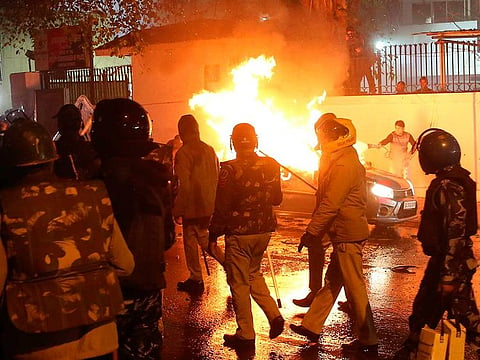Can Indian Muslims ever feel safe again?
Hindus and Muslims died in Delhi violence but weight of carnage was directed at Muslims

Process this: The dance of death and destruction unleashed in northeast Delhi last week has claimed 47 lives. More than 300 people have been injured and at least 122 houses, 322 shops and 301 vehicles have been burnt down, according to an interim report by the local administration.
In the course of 70 hours of unbridled mayhem, howling mobs armed with guns, machetes, and iron rods went around beating and killing people, looting, pillaging, and setting houses, shops and schools on fire.
And all this happened while India’s Prime Minister Narendra Modi banqueted with US President Donald Trump and the Navy band serenaded them with “Can you feel the love tonight?”
Both Hindus and Muslims died in the violence that rent Delhi over those three days. But there can be no doubt that the weight of the carnage was directed at the Muslims in the locality.
Mobs shouting “Jai Shri Ram” (which has become the war cry of militant Hindu nationalism) dragged Muslims out of their homes, brutalised them, murdered them, firebombed their houses and establishments.
The government has done nothing to stop the incendiary rhetoric of hate, nor punish those who spouted it. A Delhi High Court judge who ordered the police to register cases against the hate mongers within 24 hours, was transferred forthwith
A Muslim cemetery was desecrated, mosques vandalised, copies of the Quran torn out. Journalists covering the rampage were set upon by the bloodthirsty hordes and allowed to go only if they could prove that they were Hindus.
Amid the savagery, there have been many heart-warming tales of how Hindus protected their Muslim neighbours from the attackers. Sitting in hospitals and relief centres in the aftermath of the violence, many Muslims have expressed their gratitude towards their Hindu brothers who rescued them.
But while such tales reaffirm one’s faith in humanity, will they be enough to restore the Muslim community’s faith in the Indian state?
Police complicity
For the state has been systematically failing them. As the violence raged in Delhi, the police, which report to the county’s home minister, Amit Shah, were either mystifyingly inept in containing the mayhem or openly complicit in it. In several places, they were seen to smash roadside CCTV cameras.
Nevertheless, videos emerged which testify to their shocking complicity in what happened. In one such video, a bunch of cops surround a group of injured men, heckling them and ordering them to sing the national anthem. One of them, a 24-year-old called Faizan, later died in hospital.
The back story of the Delhi riots is, of course, the widespread protests over the government’s divisive Citizenship Amendment Act, which seeks to grant citizenship to non-Muslim immigrants from neighbouring countries. Coupled with the proposed National Register of Citizens, this has the potential to target, harass and disenfranchise millions of genuine Muslim citizens of the country.
All this happened while India’s Prime Minister Narendra Modi banqueted with US President Donald Trump and the Navy band serenaded them with “Can you feel the love tonight?”
But though the protests have been peaceful and clad in symbols of India’s democracy — the Constitution and the national flag — their steely persistence has rattled the Hindu nationalist BJP-led government. Its ministers and minions have spewed hate against them, branding the mostly Muslim protesters as traitors and urging people to shoot them.
Targetting institutions
And the government has done nothing to stop the incendiary rhetoric of hate, nor punish those who spouted it. A Delhi High Court judge who ordered the police to register cases against the hate mongers within 24 hours, was transferred forthwith.
India has seen communal violence in the past. More than a 1000 people, mostly Muslims, were killed in the Gujarat riots of 2002, which took place under the watch of Narendra Modi, who was then chief minister of the province.
Thousands of Sikhs were killed in Delhi in 1984 after Prime Minister India Gandhi was assassinated by her Sikh bodyguards. In both cases, the state machinery stood by and allowed the butchery to happen.
Delhi in 2020 was no different. But this time, the violence had an additional diabolical twist: It took place in the context of a law passed in Parliament, a law that could become a perennially existential threat to the country’s Muslims.
This time, the hate against one community has been institutionalised — metastasised, as it were — which fits neatly into the majoritarian, anti-Muslim agenda of the Rashtriya Swayamsevak Sangh, an outfit of which the BJP is a part.
In the ravaged lanes of northeast Delhi, the charred husks of homes and shops bear testimony to the carnage that took place. Thousands have fled to what they feel may be safer places. But which place is safe for them now? Last week a group of men were shouting inflammatory slogans in a busy metro station in the heart of Delhi.
On February 29, some men turned up in a village in Jhajjar on the Delhi-Haryana border and ordered the Muslim families there to clear out, or face the “consequences”.
India’s syncretic social fabric is being shredded. And last week’s violence is Delhi is a chilling prelude to that.
Shuma Raha is a noted journalist and author based in Delhi
Also Read: Carnage in Delhi must end. Now.
Sign up for the Daily Briefing
Get the latest news and updates straight to your inbox







